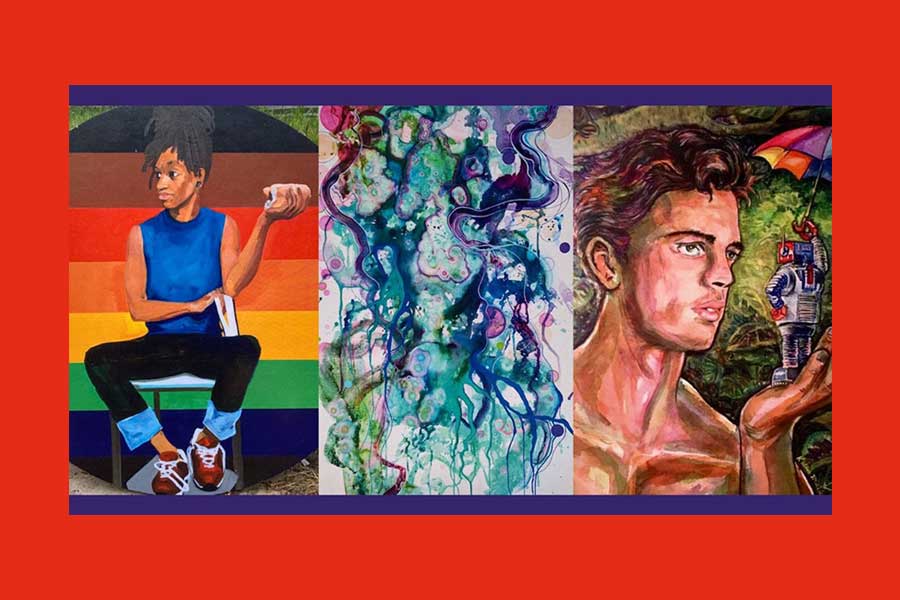At the top of the month, the work of Philly LGBTQ painters Amy Martin and Kelly McQuain were hung on the walls of William Way Community Center. Now, local photographers see a topic-wide last call for snaps for the Center’s upcoming “QUEERLIFEPHL” exhibit.
This year, WWCC will hold the 14th Annual Juried Art Exhibition Nov-Dec. The center has a permanent art collection, comprised of 250-plus individual works consisting of paintings, drawings, collage, photography, prints, sculpture and mixed-media. Additional work, part of the the John J. Wilcox, Jr. Archives, will be catalogued, photographed and placed online on the Archives’ Digital Collections site this year.
William Way has become one of this city’s most important, active art galleries, without much acknowledgement.
“There were exhibit programs previous to the present that began in 2005,” said John Anderies, Director of the Archives. “These go back to our original Gay Community Center on Kater Street with art exhibits curated by Arleen Olshan in the Gay Coffeehouse at the Center beginning in 1976. I believe art exhibit programs existed in other locations of the Center after, and before, moving into our present building in 1997.”
Unlike other Philadelphia galleries in NoLibs and Old City, there is no single, static aesthetic that defines the walls of William Way. The Way’s aesthetic approach, in the words of Janus Ourma, Independent Curator and Art Committee member, “has been one of being intentionally open to inclusivity and diversity, presenting artwork by the underrepresented members of our community as well as the art of all Queer-Americans.”
Whether considering exhibitions such as Natalie Hope McDonald’s “ICONS”, and Gabriel Martinez’s “Tonight is Forever” (immersive installations addressing the cultural history of the LGBTQ community) “Black Trans Futurism” and “Face to Face” (Trans and non-binary artists), or “4 Queer Voices” (LGBTQ graffiti artists from the Streets Department of Philadelphia), the art of William Way is about Queer people, Philadelphia Queer people.
“The experiences of Queer-Americans with rejection, pain, suffering, resistance, pride, celebration and joy are still reflected in the artworks of various artists, because frequently it is the personal experience of the artist that is the content of their artwork,” said Ourma.
In that regard, the center functions like an embassy for Queer-Americans living in Philadelphia or for visitors to the city. “A part of that responsibility is to make sure that the culture and history of the Queer-American community is presented through art exhibitions and archive exhibitions,” said Oruma.
Plans for the immediate future include video monitors to present the work of Queer videographers from Philadelphia, the U.S. and from around the world; and expand the arts programming to include the performing arts with playwrights and poets, musicians and dancers.
What that, said Oruma, the curatorial vision is rarely pointedly thematic, requiring artists to limit their focus to the interests of a specific curatorial team.
For example, the present exhibition “Queer-Americans: Who We Are,” presents works that are relevant to the contemporary repressive social context of America. Repression is mercurial and exists in many forms.
“Amy Martin is exhibiting artworks that present her femme vision of powerful dominant female figures consistent with the #MeToo movement and the fight for equality,” said Oruma.
“Kelly McQuain presents forty artworks focused on his concerns about the environment, and the quality of our relationships to each other as well as A.I. ALKOTO’s large abstract artworks express their torturous struggle with an emotional landscape involving brilliant celebration as well as uncertain doubt, emotions well known to Queer-Americans.”
For the upcoming QueerLifePHL, an idea arose through discussion with curators Keenan Bennett and Irving Chang, WWCC’s Arts Committee “brain trust” of 13 members and the Director of Programming, Celena Morrison to reach out to the entire Philadelphia Queer-American community.
“We wanted to encourage people to share any cell phone pictures that they think reflect their lives,” said Oruma. “This will be a way of the community seeing the daily lives of the community, who makes up our community, a community portrait.” QueerLifePHL’s deadline for submissions is July 26.
When I pose the question of what all of these images – installed, photographed, painted or sculpted – mean to the William Way, whether their audience or their artists, Oruma pushes the question back to me.
“Does it need to say anything? This is a perennial question that’s never easily or fully answered. There are some artists who do not want to be limited to creating art for a specific cultural community, wanting to communicate to that undifferentiated “everyman(person)”. Many Queer-American artists are unable to address their community because they are unaware of the history or characteristics that make Queer-Americans a unique cultural community. There is a critical necessity for art, the material culture of our community, to address what matters to Queer-Americans, what makes our community unique and dynamic, what makes us proud to be who we are.”
